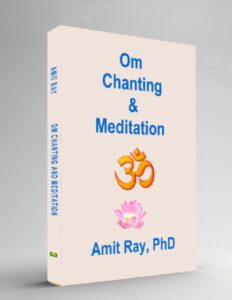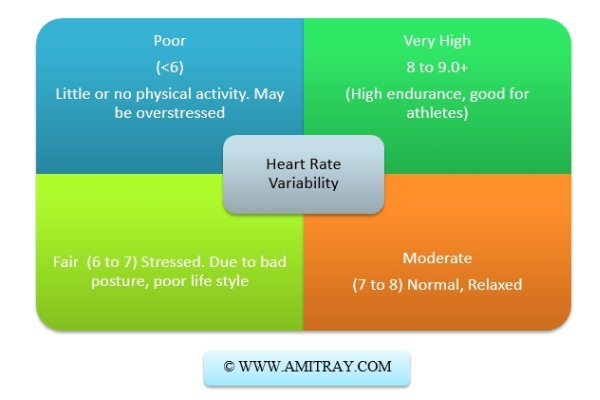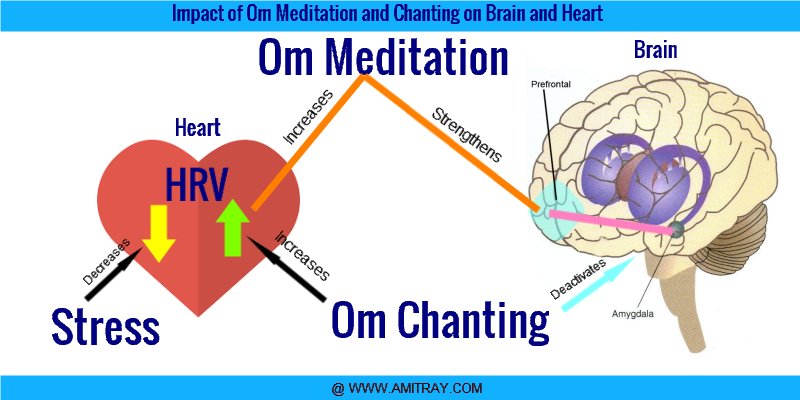Stress Relief and Heart Rate Variability with Om Meditation
Sri Amit Ray explains how Om meditation and Om chanting is related to heart rate variability and stress relief.
Your heart rate is constantly changing to meet various requirements of your body and mind. Heart Rate Variability (HRV) measures how your heart rate varies over time. Generally, heart rate variability increases during relaxation and recovering activities and decreases during stress and anxiety. HRV reflects the changes in the interval between heartbeats (R wave) over time. HRV is NOT the same as plain heart rate (HR). It’s not the “beats per minute” number most of us are familiar with.
Broadly speaking there are seven types of Om meditation. The impact of these meditations on stress level varies from person to person. HRV measurement just after different Om meditations can help you to assess the impact of your personalized meditation techniques on stress relief. The key for effective Om chanting is activating the Vayapini Nadi and the Kurma Nadi. Our studies strongly suggests that Vayapini Om chanting increases HRV and may be linked to the activation of the ventromedial prefrontal cortex regions of the brain.

Stress Relief and Heart Rate Variability with Om Meditation
Due to advancement of new sensor technologies, smartphone apps, and accessibility to high-quality wearable technology, you can measure your Heart Rate Variability (HRV) at your home and easily monitor your stress level and study the impact of Om chanting or Om meditation and other personalized meditation practices at your own, without referring to any complicated research articles, which are mostly inconclusive.
Generally, higher fitness levels result in increased HRV and lower fitness levels results in decreased HRV. High HRV is normally viewed as an indicator of a healthy heart. HRV is commonly higher when your heart is beating slowly with in-built relaxation. HRV decreases as your heart beats more quickly. HRV decreases under conditions of acute time pressure and emotional strain and elevated state of anxiety, mostly related to focused attention.
 Day-to-day normal level of stress is fine, but chronic stress is dangerous. If you become stressed and don’t sleep well in the night, you may see your HRV values are gradually lowering. Higher HRV is associated with stronger vagus nerve function, lower chronic stress levels, better overall health, and improved cognition.
Day-to-day normal level of stress is fine, but chronic stress is dangerous. If you become stressed and don’t sleep well in the night, you may see your HRV values are gradually lowering. Higher HRV is associated with stronger vagus nerve function, lower chronic stress levels, better overall health, and improved cognition.
Heart rate is the number of heartbeats per minute, while heart rate variability (HRV) is the fluctuation in the time intervals between the heartbeats. HRV measures beat-to-beat variability over a wide range of time. HRV gives better understanding about how much time our body needs to get back to normal state after an intense work activities or stress. HRV is a measure of our resilience. The average HRV score for common people is 7.0 (on a 1-10 scale).

Heart Rate Variability Levels in 0 to 10 Scale.
Stress, HRV and OM Chanting
Excessive uncertainty and ambiguity in modern first-living life style leads to excessive stress. Om meditation is an easy way to transform the stress energy into positive life force. We will discuss here, the science behind these ancient and secret meditation techniques.
There are various HRV measures like: time domain(SDNN, rMSSD), frequency domain(LF, HF) etc. We normally rely more on rMSSD due to its clear physiological link with the parasympathetic activity (the rest and recovery system).
Our autonomic nervous system regulates many body functions, mostly unconsciously, such as respiration, the heart beating and so on. It consists of two branches, the sympathetic and parasympathetic branches. The sympathetic branch, is activated during stress, in the fight or flight response, while the parasympathetic branch activates a rest, digestion and relaxation.
 Ideally for good health, these two systems of your autonomic nervous systems should work together, each taking over according to the conditions. In our ancient yoga system, sympathetic nervous system is associated with pingala nadi or surya nadi means “flow of sun light”, and the parasympathetic nervous system is associated with the ida nadi or chandra nadi means “flow of moon light.”
Ideally for good health, these two systems of your autonomic nervous systems should work together, each taking over according to the conditions. In our ancient yoga system, sympathetic nervous system is associated with pingala nadi or surya nadi means “flow of sun light”, and the parasympathetic nervous system is associated with the ida nadi or chandra nadi means “flow of moon light.”
Heart Rate Variability and the 72000 Nadis
There is another nadi which is master of ida nadi and pingala nadi, called Vayapini nadi. This Vayapini nadi is associated with the high HRV. Low frequency Om chanting and Om meditation activates the Vayapini nadi. Heart rate variability depend on the Nadi system you follow during meditation or chanting. We observed, the Maladhari Nadi and the Vayapini Nadi gives the best results. Maladhari nadi is associated with your visualization techniques, and manifestations.
OM Meditation, HRV Modulation and our Brain
Amygdala in our brain is a pivotal node in neural pathways for HRV modulation. Higher resting HRV showed increased control on amygdala by the dorsal medial prefrontal cortex and anterior cingulate cortex (dmPFC/dACC). Our studies confirmed that seven step Om meditation is tightly coupled with medial prefrontal cortex (mPFC), anterior cingulate cortex (ACC), insula, and amygdala. Stress response is associated with two physical pathways in the brain.
Modulation of prefrontal-amygdala pathway is associated with both Om meditation and HRV change. Similar observations noticed, Om chanting significantly deactivates the right amygdala. Hence, our research confirmed that phased modulation of Om chanting and Om meditation has direct positive correctional with the increase in HRV. Proper Om meditation strengthens the prefrontal cortex and the prefrontal-amygdala pathway. Om chanting deactivates the right amygdala. And they help to reduce stress levels in normal cases significantly.

Impact of Om Meditation and Chanting on Brain and Heart
HRV Measurement Timings and Om Meditation
One of the most practical ways to use HRV in your personalized Om meditation, is to look at the changes in your HRV. It can provide you the insights about your physiological stress level, a higher level of stress will show a lower in HRV. You can do these measurements 2 – 3 times per week.
You can take the first measurement just after waking up, possibly while still in bed or you can do the measurement any other time. You have to maintain a consistent time. When you take the measurement, it’s very important to try to relax, and do not think much about other things. Maintaining a constant and comfortable breathing rate during measurement is good.
Key Points:
Heart rate variability is a measure of how in balanced or imbalanced your nervous system is. When your heart rate variability is continually low, your risk of heart disease and various other health problems increases. Phased modulation of Om chanting and Om meditation has direct positive correctional with the increase in HRV. Higher resting HRV showed increased control on amygdala and related stress. Vayapini nadi is associated with the higher HRV. Proper Om chanting and Om meditation can increase your HRV and reduce your stress level significantly.
Reference:
- Ray, Amit. “Telomere Protection and Ayurvedic Rasayana: The Holistic Science of Anti-Aging.” Yoga and Ayurveda Research 4.10 (2023): 69-71. https://amitray.com/telomere-protection-and-ayurvedic-rasayana/
- Ray, Amit. “Glymphatic System Brain Health and 40 Hz Music and Mantra Chanting.” Compassionate AI 1.3 (2024): 12-14. https://amitray.com/glymphatic-system-brain-health-and-40-hz-music-and-mantra-chanting/
- Ray, Amit. “Slow Breathing Yoga Pranayama to Reduce Oxidative Stress.” Compassionate AI 1.1 (2024): 66-68. https://amitray.com/slow-breathing-yoga-pranayam-to-reduce-oxidative-stress/
- Ray, Amit. “Heart Rate Variability with Om Meditation and Chanting.” Compassionate AI, 3.9 (2019): 72-74, Compassionate AI Lab, https://amitray.com/stress-relief-and-heart-rate-variability-with-om-meditation/.
- Ray, Amit. “Reticular Activating System for Manifestation and Visualization.” Amit Ray, amitray.com 1 (2021). Reticular Activating System for Manifestation and Visualization
- Ray, Amit. “Brain-Computer Interface and Compassionate Artificial Intelligence to Serve Humanity.” Compassionate AI 1.5 (2018): 3-5. https://amitray.com/brain-computer-interface-compassionate-ai/
- Ray, Amit. “Heart Rate Variability with Om Meditation and Chanting.” Compassionate AI 3.9 (2019): 72-74. https://amitray.com/stress-relief-and-heart-rate-variability-with-om-meditation/

